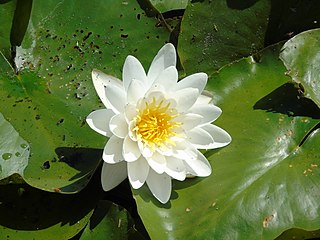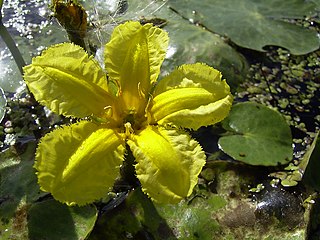
Aquatic plants are vascular plants that have adapted to live in aquatic environments. They are also referred to as hydrophytes or macrophytes to distinguish them from algae and other microphytes (phytoplanktons). In lakes, rivers and wetlands, aquatic vegetations provide cover for aquatic animals such as fish, amphibians and aquatic insects, create substrate for benthic invertebrates, produce oxygen via photosynthesis, and serve as food for some herbivorous wildlife. Familiar examples of aquatic plants include waterlily, lotus, duckweeds, mosquito fern, floating heart, water milfoils, mare's tail, water lettuce and water hyacinth.

Nymphaea is a genus of hardy and tender aquatic plants in the family Nymphaeaceae. The genus has a cosmopolitan distribution. Many species are cultivated as ornamental plants, and many cultivars have been bred. Some taxa occur as introduced species where they are not native, and some are weeds. Plants of the genus are known commonly as water lilies, or waterlilies in the United Kingdom. The genus name is from the Greek νυμφαία, nymphaia and the Latin nymphaea, which means "water lily" and were inspired by the nymphs of Greek and Latin mythology.

Vallisneria is a genus of freshwater aquatic plant, commonly called eelgrass, tape grass or vallis. The genus is widely distributed in tropical and subtropical regions of Asia, Africa, Australia, Europe, and North America.

Zosteraceae is a family of marine perennial flowering plants found in temperate and subtropical coastal waters, with the highest diversity located around Korea and Japan. Most seagrasses complete their entire life cycle under water, having filamentous pollen especially adapted to dispersion in an aquatic environment and ribbon-like leaves that lack stomata. Seagrasses are herbaceous and have prominent creeping rhizomes. A distinctive characteristic of the family is the presence of characteristic retinacules, which are present in all species except members of Zostera subgenus Zostera.

Ruppia, also known as the widgeonweeds, ditch grasses or widgeon grass, is the only extant genus in the family Ruppiaceae, with eight known species. These are aquatic plants widespread over much of the world. The genus name honours Heinrich Bernhard Rupp, a German botanist (1688–1719). They are widespread outside of frigid zones and the tropics.

Nymphoides peltata is perennial, rooted aquatic plant with floating leaves of the family Menyanthaceae.
Posidonia robertsoniae is one of the seagrasses of Western Australia, submerged flowering plants that occur in the southern coastal waters.

Aquatic Botany is a peer-reviewed scientific journal covering research on structure, function, dynamics, and classification of plant-dominated aquatic communities and ecosystems, as well as molecular, biochemical, and physiological aspects of aquatic plants. It publishes fundamental as well as applied research. The journal was established in 1975 by Cees den Hartog, who still serves as consulting editor. It is published by Elsevier and the editors-in-chief are E.M. Gross, Thomas Wernberg and Brigitta van Tussenbroek.
Ruth Mason was a New Zealand botanist specialising in the taxonomy and ecology of freshwater plants. She was employed at the Department of Scientific and Industrial Research for 35 years undertaking research into aquatic plants, pioneering new techniques for plant preservation and collecting over 13,000 plant specimens in the field. She was awarded life membership by the New Zealand Ecological Society.

Ceratophyllum submersum, commonly known as the soft hornwort or tropical hornwort, is a species of Ceratophyllum. It is a submerged, free-floating aquatic plant. It has been reported from Europe, Central Asia, northern Africa, scattered places in tropical Africa, Turkey, Oman, Florida, and the Dominican Republic. It is similar to the submerged macrophyte Ceratophyllum demersum, a congeneric plant that is found in most regions of the world.

Anthosachne is a genus of true grasses in the tribe Triticeae. It is primarily Australasian in its distribution, having five species native to New Zealand, 4 to Australia, and 1 to New Guinea. The Australian species are confined to the southern half of the continent.
Ruppia megacarpa is a submerged herb species in the genus Ruppia found in shallow brackish waters. It is a common on Australasian coasts, including Australia (NSW; SA; Vic; WA and New Zealand. Isolated populations have been currently found in East Asia, including Japan, Korea, and Far East Russia, hence, the species distribution exhibit latitudinally disjunct distribution between East Asia and Australasia.

Ruppia tuberosa is a submerged herb in the genus Ruppia found in shallow hypersaline waters in Australia.
Helen Isobel Aston was an Australian botanist and ornithologist.
Joy Thompson was an Australian botanist. Her main research areas were taxonomy and Myrtaceae.

Potamogeton tepperi is a water herb, belonging to the Potamogetonaceae family in the order Alismatales.

Posidonia australis seagrass meadows of the Manning-Hawkesbury ecoregion is an endangered ecological community, listed under the EPBC Act of the Commonwealth of Australia on 7 May 2015

Bolboschoenus planiculmis is a species of flowering plant in the sedge family Cyperaceae. It sprouts from tubers or seeds from April to May and flowers between May and July, with the aboveground biomass dying back in October. It is distributed in estuaries across and throughout East Asia, Central Asia, and Central Europe with small populations reported in Western European countries such as the Netherlands. B. planiculmis can be identified by its bifid styles as opposed to the trifid styles which are found on all other Bolboschoenus species in Europe.
Blyixa japonica is a species of plant in the family Hydrocharitaceae. It is known as Japanese blyxa or dwarf Asian grass.
Noveloa is a genus of aquatic flowering plants in the family Podostemaceae. Species of the genus are distributed across north and west Mexico in seasonally dry tropical areas, and plants are found in shallow, clear, fast-flowing rivers.














